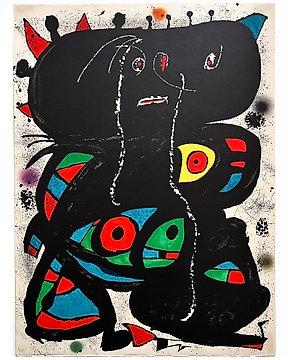
Joan Miro (1893-1983) - 76x56 cm - Hommage aux Prix Nobel 1976
Nro. 77410037

Nro. 77410037

Large hand-signed artist's proof from an edition of 50 "avant la lettre" color lithographs. Referenced in Mourlot catalogue under number 423, as well as Sala Gaspar's own 1970 catalogue under number 099. Excellent condition overall. A fun, whimsical piece of Barcelona art history by one of its most celebrated sons.
Combining Abstract Art with Surrealism, Joan Miró’s oeuvre is internationally respected.
This lithograph is related to the book Barcelona (1964), published on the occasion of the three exhibitions that take place simultaneously in this city in the Sala Gaspar, René Metrás and Belarte. In this book, Joan Miró's lithographs appear accompanied by texts by writers and critics, such as Joan Brossa, Alexander Cirici, Juan Eduardo Cirlot, J.V. Foix, Sebastiá Gasch or Rafael Santos Torroella.
Born April 20, 1893, in Barcelona, Spain, Joan Miró Ferra was exposed to art at an early age through his watchmaker father. At the age of 14, he went to business school in Barcelona while also attending La Lonja’s Escuela Superior de Artes Industriales y Bellas Artes. Choosing business over art, he took a position as a clerk, but suffered a nervous breakdown. Abandoning business, he resumed his art studies and attended Francesc Galí’s Escola d’Art in Barcelona from 1912 to 1915. Receiving early encouragement from the dealer José Dalmau, Miró’s first show occurred at his gallery in 1918 where his work was ridiculed and defaced. His works during this time reflected the influence of Fauvism and folkloric Catalan art as is seen in Chapel of Sant Joan d’Horta (1917), but he was also drawn to Cubism and Surrealism.
Those artistic interests led Miró to move to Paris in 1920, but he continued to spend his summers in Catalonia. In Paris, Miró met Pablo Picasso, and other important emerging artists and poets, encircling himself with creative types. Dalmau organized Miró’s first solo show in Paris, at the Galerie la Licorne in 1921 and his work was included in the Salon d’Automne of 1923. Strongly symbolic and poetic in nature, Miró’s art fit well within the context of the dream-like erratic tendencies espoused by Surrealism and in 1924 he joined the Surrealist group, though always remained on the periphery of Surrealism. Such works included Catalan Landscape (The Hunter) (1923) and the Tilled Field (1924).
This is around the time Miró began to develop an antagonistic attitude towards painting, and started to explore other techniques and mediums. In 1926, while collaborating with Max Ernst on designs for a ballet they pioneered the technique of grattage, in which pigment is troweled onto the canvas and in 1928 Miró began executing his first papiers collés and collages. During the early 1930s, Miró would delve into sculpture, incorporating painted stones and found objects into his three-dimensional works. This was also the time when he started his experiments in lithography, and his first etchings date to 1933, both mediums of which would comprise a majority of his oeuvre.
JOAN MIRÓ LITHOGRAPHS:
The close relationship with Fernand Mourlot resulted in the creation of over one thousand Joan Miró lithographic print editions. His process of automatic drawing, allowing the hand to move randomly on the surface, leaving the artwork to chance, enabled him to create works that were genuine reflections of himself, an integral part of his popularity. A popularity that still remains today as they make for 91% of all of his works bought on the market, with a complete set of Le lézard aux Plumes d’Or (1971) selling for over $147, 510 in 2002 from Christie’s.
A true master of the printmaking medium, Miró received the Grand Prize for Graphic Work at the Venice Biennale in 1954, and his work was included in the first Documenta exhibition in Kassel the following year. In 1958, he was given a Guggenheim International Award for murals for the UNESCO building in Paris and the following year he resumed painting, initiating a series of mural-sized canvases. During the 1960s, he began to work intensively in sculpture and was particularly captivated by glass as is evidenced in his commissioned mural Personnage Oiseaux (1972-1978) which combines one million pieces of marble and Venetian glass. A man whose art rose to international acclaim with the help of the Surrealist movement, Miró was honored with many retrospectives during his lifetime and worked until he passed away of heart disease in December 25, 1983, in Palma de Mallorca, Spain.
Näin ostat Catawikistä
1. Löydä jotain erityistä
2. Tee korkein tarjous
3. Maksa turvallisesti